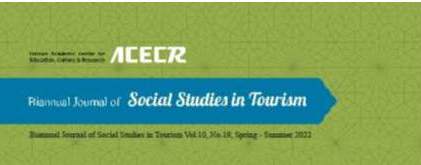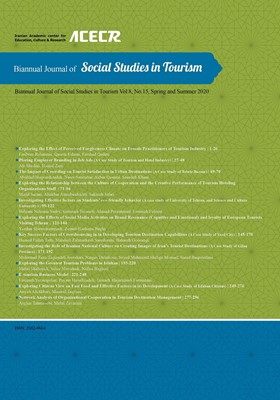-
-
List of Articles
-
Open Access Article
1 - Exploring the Effect of Perceived Forgiveness Climate on Female Practitioners of Tourism Industry
Fariborz Rahimnia Farshad Ghaderi -
Open Access Article
2 - Exploring Employer Branding in Job Ads: A Case Study of Tourism and Hotel Industry
Ali Abedini hamid zare -
Open Access Article
3 - The Impact of Crowding on Tourist Satisfaction in Urban Destinations: A Case Study of Tabriz Bazaar
Abolfazl Haghverdizadeh Naser Sanoubar Akbar Ghasemi Saeedeh Khani -
Open Access Article
4 - Exploring the Relationship between the Culture of Cooperation and the Creative Performance of Tourism Hoteling Organizations Staff
majid sarani ali akbar amin bedokhti sakineh jafari -
Open Access Article
5 - "Investigating Effective factors on Students’ eco-friendly behavior: A case study of University of Tehran, and Science and Culture University "
Bahram Nekouie Sadry Samaneh Tavasoli Ahmad Pourahmad FATEMEH FEHREST -
Open Access Article
6 - Exploring the Effects of Social Media Activities on Brand Resonance (Cognitive and Emotional) and loyalty of European Tourists Visiting Tehran
Yazdan Shirmohammadi زینب هاشمی باغی -
Open Access Article
7 - Key Success Factors of Crowdsourcing in in Developing Tourism Destination Capabilities: A Case Study of Yazd City
Hamed Fallah Tafti Mahdieh Zahmatkesh Saredorahi بهاره گورنگی -
Open Access Article
8 - Investigating the Role of Iranian National Culture on Creating Images of Iran’s Tourist Destinations: A Case Study of Gilan Province
mohamadreza taghizadeh joorshari Narges Delafrooz mamoud shabgu monsef saeed baghersalimi -
Open Access Article
9 - Exploring the Greatest Tourism Problems in Isfahan
Mehri Shahzeidi Sahar Movahedi Nafise Bagheri -
Open Access Article
10 - E-tourism Business Model
Fatemeh Yavarigohar payam hanafizadeh taraneh hajiahmadi farmahini -
Open Access Article
11 - Exploring Citizens View on Fast Food and Effective Factors in its Development: A Case Study of Isfahan Citizens
atiyeh Aliakbari masoud taghvaei -
Open Access Article
12 - Network Analysis of Organizational Cooperation in Tourism Destination Management
Asghar Tahmasebi mehri zavarniya
-
The rights to this website are owned by the Raimag Press Management System.
Copyright © 2017-2025







